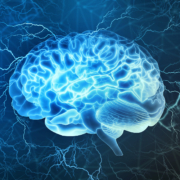How today’s world is reshaping your brain
Between the COVID-19 pandemic, climate change, constant mass shootings, social injustice, political turmoil, and 24/7 exposure to social media and misinformation, one thing’s for certain: We’re all going through a lot. New terms like “climate anxiety” and “solastalgia” are entering the lexicon to address what we’re experiencing—some even call these events “collective traumas.” If you’re feeling a general sense of stress and anxiety, that makes sense. You’re not alone.
If you’re also feeling a little numb, that makes sense, too. Our brains are powerful places—we know that we can neurally adapt in certain ways, desensitizing our brains to repeated stimuli. But studies also show that these collective traumas, despite their constancy, are taking a toll on us, with long-term consequences for our mental health.
Of course, neither numbness nor anxiety and trauma are ideal. When it comes to absorbing current events, what’s going on in our brains? And how can we healthily cope in today’s world?
Neural adaptation—your brain wants to be smart and efficient
Our brains love forming heuristics—shortcuts to making decisions and predicting patterns. This happens constantly, in both minor ways (is Simone Biles going to outperform Grace McCallum? (You’ve probably heard of Simone, so she’ll likely get your vote) and major ones (would you rather apply for a job at a workplace with one job opening or a dozen? Odds are the one with fewer openings seems more competitive and desirable).
In other words, our brains are always trying to save time and energy, down to the single-cell level, sometimes at the expense of logic—or even our senses. Heuristics, selective attention, going on “autopilot,” the list of ways our brains love efficiency goes on and on.
This energy-saving phenomenon can also be seen in the form of neural adaptation: the gradual decrease over time in responsiveness to a constant stimulus. For most neurotypical individuals, this can be seen nearly every second of every day—did you feel the texture of your chair the moment before you read this sentence? What about the background noise around you that you’re just now noticing? Your brain is making a good argument: If a stimulus keeps occurring and requires no response, why should it waste its time?
But what does the brain do with a near-constant bombardment of negative media exposure? From school shootings to misinformation to climate change, does the brain deem these incessant stimuli as worth less of a response over time? Do we grow numb to the data, or do we grow anxious and stressed? The short answer: As far as we know, it’s both.
Desensitization and stress
Neural adaptation to today’s constant barrage of negative events is a huge, nebulous topic. To demonstrate how it works, Krista Lisdahl, professor of psychology at UW–Milwaukee, starts us off with a narrower, more defined example: alcohol consumption.
“Over time, as the brain gets used to alcohol, receptors and neurotransmitters get downregulated, so they’re less available,” she explains.
With your natural baseline down—in this case, the brain’s GABA (gamma-aminobutyric acid) signaling, which reduces brain activity and provides a sense of calm—you wind up drinking more alcohol to achieve that same dopamine rush. That leads to a whole slew of negative side effects; desensitization, when gone too far, comes with repercussions.
Lisdahl points to a study that’s closer to the topic at hand, where children’s brains neurally adapted in response to adverse events like divorce, abuse, substance use, and natural disasters. At first, she explains, the children demonstrated an increased cortisol response through the hypothalamic-pituitary-adrenal axis (HPA) function—aka stress. Over time, that cortisol response blunted, and the brain’s neuronal structure changed. In this scenario, adaptation resulted in poor emotional control and reduced problem-solving skills.
“In the end,” says Lisdahl, “these things are bad for the brain.”
For more abstract stressors, such as media exposure to climate change and the Covid pandemic, we don’t have as much neural evidence, says Lisdahl—it’s a difficult study to do, never mind the unethical territory of ceaselessly bombarding individuals with triggering events. But a few topical studies do exist: One climate anxiety study found that a moderate level of media exposure was actually ideal, “encouraging people to rethink actions with negative ecological impacts.” Another study found that exposure to stressful information on climate change can be overwhelming, ultimately encouraging actions with negative ecological impacts.
Those sound contradictory, but what we know about stress tells us otherwise: In short, a moderate level of stress is good—it teaches and informs us, and we can eventually desensitize appropriately. We learn new coping strategies, explains Lisdahl, who brings up her 15-year-old learning how to drive. “When he first got behind the wheel, there was a lot of fear and hesitancy,” she says, until he was driving effortlessly on the highway two months later. “That stress increased adaptation and learning, and it was good for him.”
But go too far on either end—imagine a curve shaped like an upside-down U—and the brain either doesn’t mobilize the resources needed to meet a challenge, or it can’t regulate stress and ultimately can’t recover. If too much cortisol lives in your system, says Lisdahl, you might see increased inflammation and oxidative stress, sleep disruption, emotional regulation disruption, and maladaptive neuronal changes. Like we saw in the above children’s study, vital stress counter-regulatory systems can turn off entirely. (The same principle applies for adults, too.) These chronic stressors also have the power to hinder our cognition, with negative effects on critical cognitive functions such as memory and attention.
Clearly, desensitization and stress are a dangerous game, but there’s a wrench in this system: Some studies have found that, when it comes to things like media exposure to traumatic events, we don’t desensitize at all. Instead, we sensitize, a process with similar side effects—but one we have the power to stop.
Negative media exposure and sensitization
The Orlando shooting, the Colorado River disappearing—these are serious stories. What if our brains don’t desensitize to negative media exposure? That’s what E. Alison Holman, professor of nursing science and psychological science at the University of California–Irvine, sees in her research. Instead, negative media exposure initiates a dangerous cycle: Worrying about the future draws an individual to the media, which makes them worry about the future, which draws them to the media, and so on.
“Whether it be a hurricane or mass shooting or terrorist attacks,” Holman says, “people can develop post-traumatic stress-type symptoms, both early and across time.”
In one poignant example, Holman studied the degree of acute stress following the 2013 Boston Marathon bombings in two groups: those present at the event and those exposed through the media. On average, notes Holman, the people who were at the site reported less stress than the people who watched via the media. She attributes this in part to the media’s gravitational pull to the unnecessarily violent and dramatic: In the real world, people got to see the whole picture—an act of terrorism, yes, but also an act of the community coming together.
Holman adds that negative media exposure can compound—it doesn’t have to be one event or topic. In today’s world, from Charlottesville to Canadian wildfires to Ukraine, stressful events are coming clip after clip after clip, which can be overwhelming psychologically—your brain doesn’t get a break to relax and process. “It’s what we call ‘cascading or compounding collective events’,” she describes. “It’s those moments that work together to be very psychologically distressing for many people.”
She points to a study where individuals were given MRIs and exposed to different videos, some traumatic. The ventral occipital cortex (VOC), the part of the brain associated with the development of PTSD and other mental health issues, lit up upon viewing the violent content. Specifically, the study mentioned the VOC was associated with flashbacks, or the intrusive mental re-experiencing of traumatic events. “If we know that these things that we’re looking at are triggering,” she says, “it’s a really good idea for us to stop doing it.”
How to keep your brain healthy and engaged
Both Lisdahl and Holman independently remark that the media isn’t doing society any favors—the news gravitates toward sensational headlines and traumatic imagery to get your attention. It’s part of why the self-care movement is so huge; when it comes to the media, societal self-care doesn’t exist.
“Each person really needs to be very mindful and tuned in with their own mental health and their own stress,” says Lisdahl.
We all have different barometers for stress, and it’s important to stay in that Goldilocks zone of resiliency. Not everyone can be an activist—you have to stay engaged in a way that aligns with your values and with the time or resources that you have available.
Several NAN researchers noted the importance of caring for our physical bodies in how we mediate stress and build resiliency. Some peer-reviewed resources on those subjects are here, here, here, and here.
Holman notes that you can get a lot of knowledge from your body—if you pay attention to it. Notice your breathing, the tension you feel in your core; if you’re having a physiological response, cut it off.
“I wouldn’t even wait to that point,” she adds. “If you’re starting to feel like, ‘Oh my god, this is overwhelming,’ just turn it off.”
Both researchers suggest hard and fast limits on media exposure: 30 minutes or less per day. Both even suggest picking two neutral outlets—like the Associated Press or Reuters—and making your bite-sized news consumption routine. That also limits your exposure to misinformation, which, as other studies show, sways your emotions and opinions.
Lastly, Holman notes how important it is to connect with real people in your social world—to talk about these events, to get the support you need, to create social connections in your community.
“The way things have always been fixed or changed or made for the better,” she says, “is by people coming together and supporting each other. We can do that.”
For additional resources on dealing with climate anxiety, check out this Headspace feature, this book, and, of course, NAN’s brain health brochure.
This article has been factchecked by members of NAN’s Publications Committee. For more about that process, click here.









